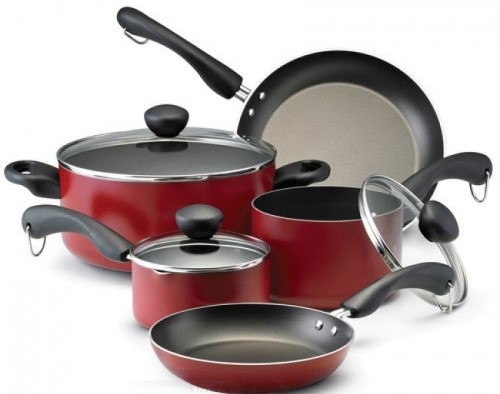ICMR Advisory Against Using Non-stick Pans Issued

ICMR Advisory Against Using Non-stick Pans Issued
There’s ongoing debate regarding the safety of nonstick coatings like Teflon, with some arguing they pose health risks.
20th May 2024
Many individuals globally rely on nonstick cookware in their daily cooking, finding it particularly handy for preparing delicate dishes that could otherwise stick to the pan’s surface. However, there’s ongoing debate regarding the safety of nonstick coatings like Teflon. While some argue they pose health risks, potentially associated with conditions like cancer, others contend that cooking with nonstick cookware is entirely harmless.
Nonstick cookware, like frying pans and saucepans, is coated with a substance known as polytetrafluoroethylene (PTFE), commonly referred to as Teflon. Teflon, a synthetic chemical composed of carbon and fluorine atoms, was developed in the 1930s and offers a nonreactive, nonstick and nearly frictionless surface. This characteristic makes Teflon-coated cookware convenient for cooking and easy to clean, requiring minimal oil or butter, thus promoting low-fat cooking methods.
Besides its use in cookware, Teflon finds applications in various other products such as wire and cable coatings, fabric and carpet protectors and waterproof outdoor clothing like raincoats. However, concerns about the safety of nonstick cookware have arisen over the last decade. These concerns primarily revolve around perfluorooctanoic acid (PFOA), a chemical formerly utilised in the production of nonstick cookware but no longer used. Investigations have also examined the risks linked to overheating Teflon.
In the updated Dietary Guidelines for Indians (DGIs), the Indian Council for Medical Research (ICMR) and the National Institute of Nutrition (NIN) have cautioned against the use of non-stick cookware due to health concerns related to the presence of PFOA and PFOS in Teflon coatings. Instead, ICMR recommends choosing environmentally-friendly alternatives such as ceramic, cast iron and stainless-steel cookware.
Recent studies and concerns expressed by health professionals have brought attention to the potential hazards associated with nonstick cookware, prompting consumers to reassess their usage in everyday cooking.
One of the main concerns associated with nonstick cookware involves the presence of perfluorooctanoic acid (PFOA) and perfluorooctanesulfonic acid (PFOS), chemicals utilised in the production of nonstick coatings like Teflon. When nonstick cookware is exposed to high temperatures, these chemicals can emit harmful fumes, potentially endangering individuals exposed to them. Inhaling these fumes has been associated with various health issues, including respiratory ailments, thyroid disorders and certain forms of cancer. PFOA falls within the broader category of chemicals known as per- and polyfluoroalkyl substances (PFAS). Although PFOA has been largely phased out, other PFAS compounds might still be present in certain nonstick cookware products.
Nonstick cookware, especially those coated with polytetrafluoroethylene (PTFE or Teflon), has the potential to emit harmful fumes if overheated, which can lead to flu-like symptoms in humans and prove fatal to birds. Although direct correlations to cancer in humans are not definitively established, perfluorooctanoic acid (PFOA), previously employed in Teflon production, is considered a potential carcinogen. Adhering to cooking at low to medium heat levels and refraining from using scratched or damaged pans can help reduce associated risks.
Over time, the nonstick coating on cookware may degrade, especially when subjected to high heat or harsh cleaning methods. As this coating breaks down, there’s a potential for it to leach into food during cooking, exposing consumers to harmful substances. This concern is heightened when cooking acidic foods or using metal utensils, as these can expedite the deterioration of the nonstick coating. Cooking with nonstick pans at elevated temperatures can pose health hazards. Therefore, it’s essential to cook on medium to low heat settings to prevent overheating and the release of toxic fumes. Using utensils made of wood, silicone or plastic is recommended to prevent scratching the nonstick surface, thus extending the pan’s lifespan and reducing the risk of ingesting the coating.
Aside from health considerations, nonstick cookware presents potential environmental hazards. The manufacturing and disposal processes of nonstick coatings entail the use of chemicals that can be environmentally harmful and persist in ecosystems for prolonged periods. Incorrect disposal practices of nonstick cookware can exacerbate pollution and environmental deterioration.
Due to these apprehensions, numerous consumers are shifting towards eco-conscious alternatives for their culinary requirements. One popular choice is ceramic cookware, crafted from natural substances like clay and sand and finished with a ceramic glaze. Ceramic cookware provides nonstick features akin to conventional nonstick varieties.
Ceramic cookware stands out as one such choice, crafted from natural elements like clay and sand, and finished with a ceramic glaze. It offers non-stick properties akin to traditional non-stick cookware but without the use of harmful chemicals. Ceramic cookware is lauded for its durability, scratch resistance and ability to withstand high temperatures.
Another environmentally-conscious option is cast iron cookware, renowned for its exceptional heat retention and even heat distribution. Unlike non-stick varieties, cast iron cookware is devoid of synthetic coatings and chemicals, rendering it safe and eco-friendly for cooking. Though it necessitates seasoning and proper care to prevent rusting, many users appreciate its longevity and versatility.
Stainless steel cookware is also gaining popularity among eco-minded consumers. Crafted from durable and recyclable materials, stainless steel cookware boasts freedom from harmful coatings and chemicals. It exhibits resistance to corrosion and staining, making it a sustainable choice for household chefs.
A few tips to minimise risks:
· Avoid preheating empty pans, as they can rapidly reach high temperatures, potentially releasing harmful polymer fumes. Always ensure there is food or liquid in pots and pans before preheating.
· Opt for medium or low heat settings instead of cooking on high heat, as excessive temperatures can exceed the recommended limits for nonstick cookware. Avoid broiling, which requires temperatures unsuitable for nonstick surfaces.
· Maintain kitchen ventilation by turning on exhaust fans or opening windows while cooking to dissipate any fumes that may accumulate.
· Use utensils made of wood, silicone, or plastic to prevent scuffing and scratching of the nonstick coating. Metal utensils should be avoided as they can damage the surface.
· Wash pots and pans by hand using a gentle sponge and warm, soapy water. Avoid abrasive materials like steel wool or scouring pads, which can scratch the nonstick surface.
· Monitor the condition of your cookware and replace it when the Teflon coating shows signs of deterioration, such as excessive scratches, peeling, flaking or chipping.







